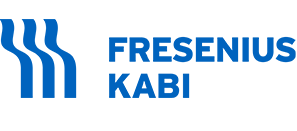INSTRUCTIONS FOR USE
How to Use
Glucagon Emergency Kit for Low Blood Sugar
Read the Instructions for Use before you start using Glucagon and each time you get a refill. There may be new information. This information does not take the place of talking with your doctor about your medical condition or treatment. Talk to your doctor or pharmacist if you have any questions about how to use Glucagon.
Important:
- Read and become familiar with the Instructions for Use before an emergency happens.
- Show your family members and others where you keep your Glucagon Emergency Kit for Low Blood Sugar and how to use it the right way.
- Call for emergency medical help right after you use Glucagon.
- Do not share your Glucagon syringes or needles with another person. You may give other people a serious infection or other people may get a serious infection from you.
- The prefilled syringe that comes with your Glucagon Emergency Kit for Low Blood Sugar is meant for use with Glucagon only. Do not use Glucagon syringes to inject other medicines.
How should I store Glucagon?
Before you mix the Glucagon powder and liquid:
- Store Glucagon at room temperature between 68° to 77°F (20° to 25°C). Check the expiration date on your vial of Glucagon. Do not use Glucagon if the expiration date has passed.
- Do not freeze Glucagon.
- Keep Glucagon in its original package and Glucagon out of light.
After you mix the Glucagon powder and liquid:
- Use Glucagon right away.
- Throw away any unused Glucagon.
- Glucagon should be clear and colorless. Do not use Glucagon if it is cloudy or if you see particles in the solution.
Supplies you will need for your Glucagon injection (See Figure A):
- 1 Glucagon Emergency Kit for Low Blood Sugar that contains:
o 1 vial that contains 1 mg of Glucagon for injection and 1 prefilled glass syringe with attached needle that contains 1 mL of Sterile Water for Injection.

Figure A
- 1 puncture resistant container for throwing away used needles and syringes. See “How should I dispose of (throw away) used Glucagon prefilled syringes” at the end of these instructions.
- Cotton ball or gauze pad (not included in kit)
Preparing the Glucagon dose:
- The Glucagon medicine comes as a dry powder. Before you use Glucagon, you must mix the dry powder with the syringe of sterile water that comes in the Glucagon Emergency Kit for Low Blood Sugar. Do not use any other liquid to mix the medicine.
- Check that the orange plastic cap on your vial of Glucagon is firmly attached. Do not use the vial of Glucagon if the orange plastic cap is loose or missing.
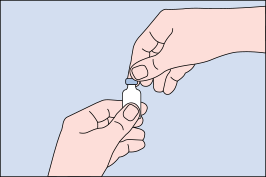
Figure B
Step 1. Using your thumb, flip the orange plastic cap off the Glucagon vial (See Figure B).
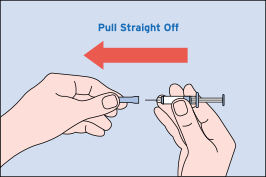
Figure C
Step 2. Pick up the prefilled syringe containing sterile water. Hold the syringe with 1 hand and with your other hand pull the needle cover off the syringe (See Figure C).
- Do not remove the plastic backstop from the syringe.
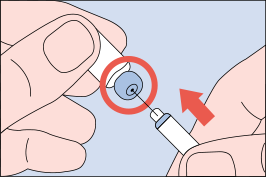
Figure D
Step 3. Pick up the Glucagon vial. Hold the vial of dry powder with 1 hand and with your other hand push the needle of the prefilled syringe through the center of the rubber stopper (See Figure D).
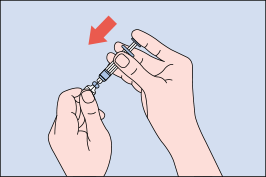
Figure E
Step 4. Hold the vial and syringe together, with the needle still inserted into the vial. Carefully turn the vial and syringe together right side up. Slowly push the plunger down until the syringe is empty (See Figure E).
- Do not take the syringe out of the vial.
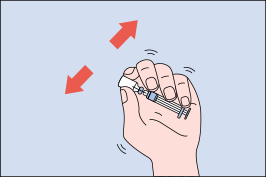
Figure F
Step 5. Hold the entire unit (the vial and syringe) in 1 hand and gently shake the vial until the powder is completely dissolved (See Figure F).
- Do not use if it is cloudy or if you see particles in the solution.
- Do not take the syringe out of the vial.
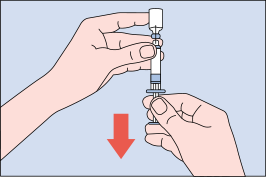
Figure G
Step 6. Firmly hold the vial and syringe together, with the needle still inserted into the vial. Carefully turn the vial and syringe together upside down. Gently pull down on the plunger and slowly withdraw all of the liquid into the syringe (See Figure G).
- Do not pull the plunger out of the syringe.
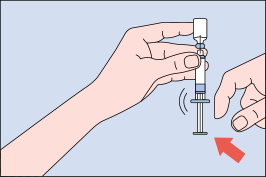
Figure H
Step 7. Keep the needle inside the vial. Check the syringe for air bubbles. If you see bubbles, tap the syringe until the bubbles rise to the top of the syringe (See Figure H). Gently push on the plunger to move only the air bubbles back into the vial.
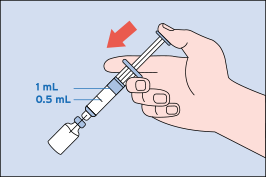
Figure I
Step 8. Hold the vial and syringe as shown (See Figure I).
Giving the Glucagon for Injection:
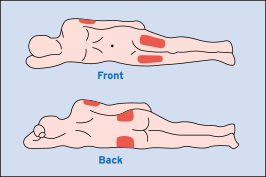
Figure J
Step 9. Choose the injection site (See Figure J).
Common injection sites for Glucagon are upper arms, thighs, or buttocks. Patient does not need to be laying down to administer the medication as long as the common injection sites can be easily accessed.
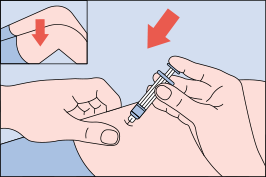
Figure K
Step 10. With 1 hand gently pinch the skin at the injection site. With your other hand insert the needle into the skin and push the syringe plunger down until the syringe is empty (See Figure K).
After Giving the Glucagon Injection:
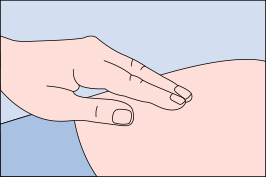
Figure L
Step 11. Pull the needle out of the skin and press on the injection site (See Figure L). Use a gauze pad or cotton ball (not included in the kit) if needed to press the injection site to make sure there is no direct contact with the skin.
Throw away your used syringe with the needle attached and any Glucagon you did not use. See “How should I dispose of (throw away) used Glucagon prefilled syringes” at the end of these instructions.
Step 12. Turn the person on their side. When an unconscious person awakens, they may vomit. Turning the person on their side will lessen the chance of choking.
Step 13. Call for emergency medical help right away. If the person does not respond after 15 minutes, another dose may be given, if available.
Step 14. Feed the person as soon as they are awake and able to swallow.
Give the person a fast acting source of sugar (such as a regular soft drink or fruit juice) and a long acting source of sugar (such as crackers and cheese or a meat sandwich).
Step 15. Even if the Glucagon for Injection treatment wakes the person, tell their doctor right away. The doctor should be told whenever a severe drop in blood sugar (hypoglycemia reaction) happens. The person’s dose of diabetes medicine may need to be changed.
Hypoglycemia may happen again after receiving Glucagon for Injection treatment.
Early symptoms of hypoglycemia may include:
- sweating
- drowsiness
- dizziness
- sleep disturbances
- irregular heartbeat (palpitation)
- anxiety
- tremor
- blurred vision
- hunger
- slurred speech
- restlessness
- depressed mood
- tingling in the hands, feet, lips, or tongue
- irritability
- abnormal behavior
- lightheadedness
- unsteady movement
- inability to concentrate
- personality changes
- headache
If not treated early, hypoglycemia may worsen and the person may have severe hypoglycemia. Signs of severe hypoglycemia include:
- confusion
- unconsciousness
- seizures
- death
How should I dispose of (throw away) Glucagon pre-filled syringes?
- Put used syringes in a FDA-cleared sharps disposal container right away after use. Do not throw away (dispose of) loose needles and syringes in your household trash.
- If you do not have a FDA-cleared sharps disposal container, you may use a household container that is:
- made of a heavy-duty plastic,
- can be closed with a tight-fitting, puncture-resistant lid, without sharps being able to come out,
- upright and stable during use,
- leak-resistant, and
- properly labeled to warn of hazardous waste inside the container.
- When your sharps disposal container is almost full, you will need to follow your community guidelines for the right way to dispose of your sharps disposal container. There may be state or local laws about how you should throw away used needles and syringes. For more information about safe sharps disposal, and for specific information about sharps disposal in the state that you live in, go to the FDA’s website at: www.fda.gov/safesharpsdisposal.
- Do not dispose of your used sharps disposal container in your household trash unless your community guidelines permit this. Do not recycle your used sharps disposal container.
Keep Glucagon and all medicines out of the reach of children.
The Instructions for Use have been approved by the U.S. Food and Drug Administration. Approved: 09/2019
The brand names mentioned in this document are the trademarks of their respective owners.
Manufactured by:
Fresenius Kabi
Lake Zurich, IL 60047

